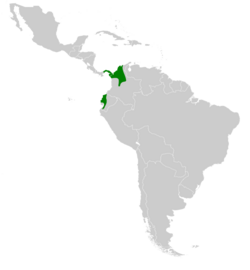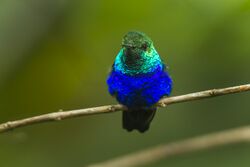Biology:Violet-bellied hummingbird
| Violet-bellied hummingbird | |
|---|---|

| |
| Scientific classification | |
| Domain: | Eukaryota |
| Kingdom: | Animalia |
| Phylum: | Chordata |
| Class: | Aves |
| Clade: | Strisores |
| Order: | Apodiformes |
| Family: | Trochilidae |
| Genus: | Chlorestes |
| Species: | C. julie
|
| Binomial name | |
| Chlorestes julie (Bourcier, 1843)
| |

| |
| Synonyms | |
|
Juliamyia julie, Damophila julie | |
The violet-bellied hummingbird (Chlorestes julie) is a species of hummingbird characterized by the male's shimmering violet belly.[2]
Taxonomy and systematics
The scientific name of this bird is currently Chlorestes julie, however, it was previously described as Juliamyia julie.[3] Its genus being Chlorestes which is in the hummingbird family: Trochilidae.[4] This family belongs to the order Apodiformes which includes hummingbirds and swifts.[5] Within this species rank are three subspecies: panamensis, julie, and feliciana.[2] Each are only separated by very minute features. Chlorestes julie panamensis occurs in Panama and has a head the same dull metallic green color as its back.[3] Chlorestes julie julie and feliciana both have a brilliant green metallic back although julie has a shorter bill (14.5 mm) and a bluer belly whereas feliciana has a longer bill (15.1 mm) and a more violet belly.[3] While julie occurs in Northern Columbia, feliciana occurs in western Ecuador and the extremely northwestern parts of Peru.[2]
Description
The violet-bellied hummingbird is characterized by the male's shimmering violet belly.[2] The rest of its body is just as brilliant; its back and crown being a metallic green.[2] The violet belly, however, is not shared between the sexes as this species exhibits sexual dimorphism.[6] The characteristics they do share include long, rounded tails, straight and short bills, and pink lower mandibles.[6][2]
Plumage
Adult:
- The male violet-bellied hummingbird is more brightly colored than its female counterpart.[2] Its breast and belly is a violet blue while its back, crown, and throat is a metallic green.[2] While the rump is more of a bronze green.[2] The rectrices are a blue black while the belly and undertail coverts are a dull black with a blue/green sheen.[2] Around the tibia are white tufts which are framed by partly white spots on its belly.[2] The feathers on its wings are dusky with a purple sheen.[2] On average males are 7.5 cm long and weigh 3.4 g.[7][2]
- The female violet-bellied hummingbird is more dull than its male counterpart.[2] Though its back, crown, and throat, is a similar metallic bronze green, its belly is a pale gray rather than a bright violet.[2] Its rump and uppertail coverts are more bronze than green while undertail coverts are a dull brown gray.[2] The rectrices can also be a blue black or a blueish green, and the outer rectrices are tipped with pale gray.[2] Similar to the males, the females' wings are dusky with a purple sheen.[2] Commonly in subspecies panamensis, the sides of the throat may be spotted with metallic green.[2] On average females are 7 cm long and weigh 3.0 g.[2][7]
Juvenile plumage has only been documented for immature males. They appear similar to an adult female although they may have some patches of violet on their belly or a sparkling green foreneck.[2][6]
The molt pattern of this species is also yet to be described.
Audio
Similar species
Violet-bellied hummingbirds are very easily confused with woodnymphs.[2] The green crowned woodnymph, in particular, has a similar color and shape and their ranges overlap.[8] To tell them apart, you must check their size, color, and tail; violet-bellied hummingbirds are smaller, their backs are green instead of violet, and their tails are rounded, not notched.[2] Green crowned woodnymphs also have a violet forecrown.[2] Another similar species is the Sapphire-throated Hummingbird because of its colors.[2] However, it has a blue throat, a green belly, and a notched tail.[2]
Distribution and habitat
Violet-bellied hummingbirds are found in central Panama, through Columbia, extending to southwestern Ecuador and the extreme northwestern point of Peru.[2] Different subspecies have different habitats within this range (see Taxonomy and Systematics section). None of which experience seasonal migration.[2] This species is present in the understory of humid deciduous forests, forest edges, and regrowth forests.[2]
Behavior and ecology
Breeding
As with many species of hummingbirds, violet-bellied hummingbirds seem to be polygynous.[2] Males mate with multiple females and attract them by singing on perches about 1–10 m high.[2] They may also fly in a 'u' shape in front of the females.[9] However, after mating, they leave the female to rear the young.[9] Individuals do not mate for life nor do they aggregate in flocks.[9]
The females are responsible for creating nests and rearing the young.[9] She creates a nest from plant fibers, animal hair and feathers in a shrub or a tree, approximately 1.2 to 4.2 m above ground.[9][2] She will then incubate the clutch of two white eggs, each 8 by 13 mm.[2] Incubation lasts 15 days followed by a 20-22 day nestling period.[2] The chicks are altricial when they hatch and thus rely on their mother to feed and defend them.[9] If successful, violet-bellied hummingbirds go on to live for approximately 4.2 years.[10]
Food and feeding
Violet-bellied hummingbirds are primarily considered nectarivorous but may more accurately be called omnivorous.[2] They consume nectar from plants in the Rubiaceae, Ericaceae, Gesneriaceae (Besleria), and Fabaceae (Inga) families.[2] They also eat small arthropods, as do many other species of hummingbirds.[2] Males may defend their feeding territory from other males and large insects.[9] Although violet-bellied hummingbirds do not form flocks, they may congregate at fruit trees and feeders.[8] The violet-bellied hummingbird's predators are not known.
Threats
According to their IUCN Red List conservation status of least concern, the violet-bellied hummingbird does not seem to be threatened.[10] They are tolerant to disturbed areas such as forest edges.[2]
In Culture
Tourists and locals alike may join in Bird watching tours around Panama where the violet-bellied hummingbird is one of the featured birds.[11]
Status
The violet-bellied hummingbird is assessed as least concern by the IUCN Red List conservation status.[10] Their population remains large and they have a wide distribution.[10]
References
- ↑ "Appendices | CITES". https://cites.org/eng/app/appendices.php.
- ↑ 2.00 2.01 2.02 2.03 2.04 2.05 2.06 2.07 2.08 2.09 2.10 2.11 2.12 2.13 2.14 2.15 2.16 2.17 2.18 2.19 2.20 2.21 2.22 2.23 2.24 2.25 2.26 2.27 2.28 2.29 2.30 2.31 2.32 2.33 2.34 2.35 2.36 2.37 Schulenberg, Thomas S. (2020-03-04), Billerman, Shawn M.; Keeney, Brooke K.; Rodewald, Paul G. et al., eds., "Violet-bellied Hummingbird (Juliamyia julie)" (in en), Birds of the World (Cornell Lab of Ornithology), doi:10.2173/bow.vibhum1.01, https://birdsoftheworld.org/bow/species/vibhum1/1.0/introduction, retrieved 2020-10-11
- ↑ 3.0 3.1 3.2 Ridgway, Robert (1881). Nomenclature of North American birds chiefly contained in the United States National Museum. Washington, DC: Govt. Print. Off.. doi:10.5962/bhl.title.57047. http://dx.doi.org/10.5962/bhl.title.57047.
- ↑ Winkler, David W.; Billerman, Shawn M.; Lovette, Irby J. (2020-03-04). Billerman, Shawn M; Keeney, Brooke K; Rodewald, Paul G et al.. eds. "Hummingbirds (Trochilidae)" (in en). Birds of the World. doi:10.2173/bow.trochi1.01. https://birdsoftheworld.org/bow/species/trochi1/cur/introduction.
- ↑ Parker, Charles Thomas; Garrity, George M (2003). Parker, Charles Thomas; Garrity, George M. eds. Roseovarius halocynthiae, Aliiroseovarius halocynthiae, Pseudoroseovarius halocynthiae. doi:10.1601/ex.22952. http://dx.doi.org/10.1601/ex.22952.
- ↑ 6.0 6.1 6.2 "Avise's Birds of the World". https://avise-birds.bio.uci.edu/apodiformes/trochilidae/damophila_julie/index.html.
- ↑ 7.0 7.1 Ridgley, Robert S.; Greenfield, Paul J. (2003). "The Birds of Ecuador". The Auk 120 (2): 562–568. doi:10.2307/4090213. ISSN 0004-8038. http://dx.doi.org/10.2307/4090213.
- ↑ 8.0 8.1 Athanas, Nick; Greenfield, Paul J. (2016-12-31). Birds of Western Ecuador: A Photographic Guide. Princeton: Princeton University Press. doi:10.1515/9781400880706. ISBN 978-1-4008-8070-6. http://www.degruyter.com/view/books/9781400880706/9781400880706/9781400880706.xml.
- ↑ 9.0 9.1 9.2 9.3 9.4 9.5 9.6 "Violet-bellied Hummingbirds | Beauty of Birds". https://www.beautyofbirds.com/violetbelliedhummingbirds.html.
- ↑ 10.0 10.1 10.2 10.3 IUCN (2016). "Juliamyia julie: The IUCN Red List of Threatened Species" (in en). IUCN Red List of Threatened Species 2016. doi:10.2305/IUCN.UK.2016-3.RLTS.T22687411A93150678.en. https://www.iucnredlist.org/species/22687411/93150678.
- ↑ "Panama Bird Watching Tours" (in en). https://www.justadventurespanama.com/copia-de-day-tours.
External links
- Violet-bellied Hummingbird photo avesphoto
- Violet-bellied Hummingbird photo; Article
- Violet-bellied Hummingbird photo (?); Article page; Article Colombia Curiosa
Wikidata ☰ Q27074781 entry
 |



